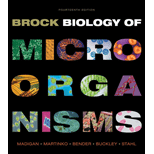
Brock Biology of Microorganisms (14th Edition)
14th Edition
ISBN: 9780321897398
Author: Michael T. Madigan, John M. Martinko, Kelly S. Bender, Daniel H. Buckley, David A. Stahl, Thomas Brock
Publisher: PEARSON
expand_more
expand_more
format_list_bulleted
Concept explainers
Question
Chapter 22.11, Problem 1MQ
Summary Introduction
The squid, Euprymna scolopes is a marine invertebrate. On ventral side of this organism, a light organ is present and it harbors the huge population of the Aliivibrio fischeri. This bacterium is a gram-negative and bioluminescent organism. The squid and Aliivibrio fischeri share a mutualistic association with each other.
Expert Solution & Answer
Want to see the full answer?
Check out a sample textbook solution
Students have asked these similar questions
How is the correct bacterial symbiont selected in the squid–Aliivibrio symbiosis?
pls give me short answer of this
Describe the symbiosis between the Riftia tubeworm and its bacterial symbiont. What is the role of the Riftia tube worm hemoglobin in the success of its relationship with the symbiotic bacteria?
Why would you be surprised to find the exact same microbial symbionts inhabiting squid and the rumen of a cow? Consider both the physical and chemical conditions of the habitat and the requirements for the symbiosis to be successful.
Chapter 22 Solutions
Brock Biology of Microorganisms (14th Edition)
Ch. 22.1 - Prob. 1MQCh. 22.1 - Prob. 2MQCh. 22.2 - What is the evidence that "Chlorochromatium...Ch. 22.2 - Prob. 2MQCh. 22.2 - How might nutrients be shuttled between phototroph...Ch. 22.3 - Prob. 1MQCh. 22.3 - Prob. 2MQCh. 22.3 - What is a bacteroid and what occurs within it?...Ch. 22.3 - What are the major similarities and differences...Ch. 22.4 - Prob. 1MQ
Ch. 22.4 - How do the vir genes differ from T-DNA in the Ti...Ch. 22.4 - How has an understanding of crown gall disease...Ch. 22.5 - Prob. 1MQCh. 22.5 - Prob. 2MQCh. 22.5 - How do mycorrhizal fungi promote plant diversity?Ch. 22.6 - Prob. 1MQCh. 22.6 - Prob. 2MQCh. 22.7 - Prob. 1MQCh. 22.7 - Prob. 2MQCh. 22.7 - Prob. 3MQCh. 22.8 - Prob. 1MQCh. 22.8 - Prob. 2MQCh. 22.8 - Prob. 3MQCh. 22.9 - Prob. 1MQCh. 22.9 - What are the consequences of symbiont genome...Ch. 22.9 - How could it be determined if a symbiont and its...Ch. 22.10 - How are anoxic conditions maintained in the...Ch. 22.10 - Why does reductive acetogenesis predominate over...Ch. 22.10 - Prob. 3MQCh. 22.11 - Prob. 1MQCh. 22.11 - Prob. 2MQCh. 22.12 - Prob. 1MQCh. 22.12 - What are the similarities of the obligate...Ch. 22.12 - Prob. 3MQCh. 22.13 - Prob. 1MQCh. 22.13 - Prob. 2MQCh. 22.13 - Prob. 3MQCh. 22.14 - Prob. 1MQCh. 22.14 - What are the two mechanisms of Symbiodinium...Ch. 22.14 - Prob. 3MQCh. 22 - Prob. 1RQCh. 22 - Prob. 2RQCh. 22 - QDescribe the steps in the development of root...Ch. 22 - Prob. 4RQCh. 22 - Prob. 5RQCh. 22 - REVIEW QUESTIONS
6. What is a rumen and how do the...Ch. 22 - QGive an example of a single microbial species...Ch. 22 - Prob. 8RQCh. 22 - Prob. 9RQCh. 22 - Prob. 10RQCh. 22 - QHow do the microbial communities of higher and...Ch. 22 - Prob. 12RQCh. 22 - How is the correct bacterial symbiont selected in...Ch. 22 - Prob. 14RQCh. 22 - Prob. 15RQCh. 22 - Prob. 16RQCh. 22 - Imagine that you have discovered a new animal that...
Knowledge Booster
Learn more about
Need a deep-dive on the concept behind this application? Look no further. Learn more about this topic, biology and related others by exploring similar questions and additional content below.Similar questions
- What features of the squid–Aliivibrio symbiosis make it an idealmodel for studying animal–bacterial symbioses?arrow_forwardIn terms of geographical distribution, are parasitic flagellates (e.g., Trypanosoma spp., Leishmania tropica, Giardia lamblia, Trichomonas) cosmopolitan or localized? Explain Discuss the relationship between vector distribution of some parasites and their vectors, if any? Do they exhibit vector specificity?arrow_forwardConsidering both habitat conditions and requirements for successful symbiosis, why should you be surprised that squid and the rumen of a cow have the exact same microbial symbiots?arrow_forward
- How can human acquire hookworm infection?arrow_forwardExplain the ecological setting of Salmonella --- where does it live? Where does it like to live?arrow_forwardBacteria of the genus Mycoplasma are distinguished from other bacterial cells by 1) cell walls composed solely of amino acids. O 2) the absence of a cytoplasmic membrane. O 3) the absence of a cell wall. O 4) Have large capsules. 5) the presence of mycolic acid in their cell walls.arrow_forward
- What is the morphology of the following cells? diplococci sacrina tetrad streptococciarrow_forwardDescribe the life cycle of Toxoplasma gondii, where does Toxoplasma "want" to be? How does toxo gets into rats and deal with the problems of being stuck in the wrong host animal?arrow_forwardWhy can it be said that N. equitans is both a carbon and anenergy parasite?arrow_forward
arrow_back_ios
SEE MORE QUESTIONS
arrow_forward_ios
Recommended textbooks for you

12DaysinMarch, Genital Infections for USMLE Step One; Author: Howard Sachs;https://www.youtube.com/watch?v=66zR_FypVFQ;License: Standard youtube license